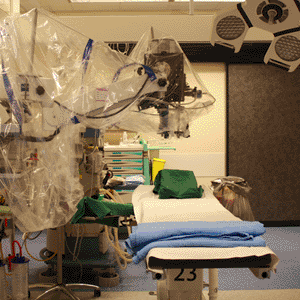New Imaging Technique Visualizes Cancer During Ovarian Cancer Surgery
By MedImaging International staff writers
Posted on 13 Oct 2011
A new study performed on nine patients with ovarian cancer in Germany has shown that new multispectral fluorescence technology can be used to localize cancer cells during surgery.Posted on 13 Oct 2011
Ovarian cancer is one of the most frequent forms of cancer that affect women. As tumors can initially grow unchecked in the abdomen without causing any major symptoms, patients are usually diagnosed at an advanced stage and have to undergo surgery plus chemotherapy. During the operation, surgeons attempt to remove all tumor deposits as this leads to improved patient prognosis. To do this, however, they mostly have to rely on visual inspection and palpation-- an enormous challenge especially in the case of small tumor nests or remaining tumor borders after the primary tumor excision.

Image: The new multispectral fluorescence imaging system visualizes tumor cells during surgery (Photo courtesy of TUM).
However, surgeons could now be getting support from a new multispectral fluorescence imaging system developed by a team of researchers from the Technische Universität München (Munich, Germany), headed by Vasilis Ntziachristos, a professor of biologic imaging. Before the operation, the patients were injected with folic acid chemically coupled to a green fluorescent dye. Most ovarian tumors have a protein molecule on their surface that bonds with folic acid and transports it inside the cell. This protein is known as the folate receptor alpha. During abdominal surgery, the surgeon can then shine a special laser light onto the patient’s ovaries, causing the green-labeled folic acid inside the cancer cells to emit light. Healthy tissue remains dark.
The fluorescent cancer cells, however, cannot be detected by the naked eye. Three cameras, mounted on a pivoting support arm over the operating table, detect optical and fluorescent signals at multiple spectral bands and then correct for light variations due to illumination and tissue discolorations in order to provide truly accurate fluorescence images that can be simultaneously displayed with corresponding color images on monitors in the operating room. The surgeon can therefore check whether all the cancer cells have been removed by inspecting for remnant fluorescence light. In eight of the nine patients, physicians were able to remove small clusters of tumor cells that might otherwise have gone undetected. The multispectral fluorescence imaging system has thus passed its first operating room (OR) evaluation. However, it will have to validate its benefits to improve clinical outcome in further operations before it can be deployed for routine surgical procedures.
The researchers also want to develop additionally the camera system so it can be used to detect other forms of tumors during operations. Of considerable importance in future developments is the ability to offer accurate fluorescence imaging so that data collected reflect the accurate presence of disease.
“The use of advanced, real-time optical technology will allow us to standardize data collection and accuracy so that studies performed at multiple clinical centers can be accurately compared and analyzed,” explained Prof. Ntziachristos. This is important for the clinical acceptance of the technology and its approval by regulatory agencies. In the future patient selection through customized medicine approaches, for example, by obtaining a molecular profile of the tumor of each patient, would further enable customized surgical treatment of improved accuracy. The team is also planning to construct a version for minimally invasive operations.
Related Links:
Technische Universität München














